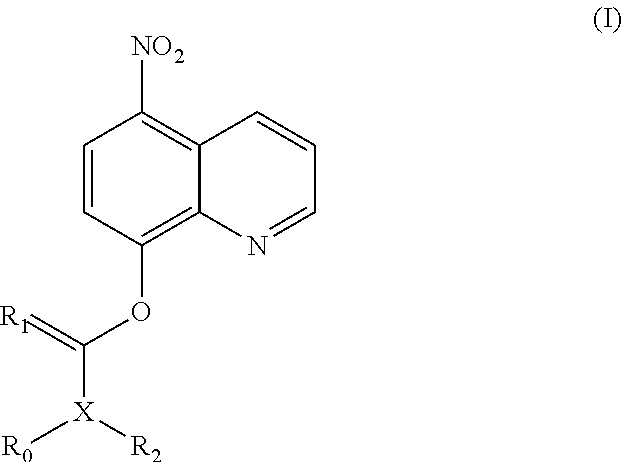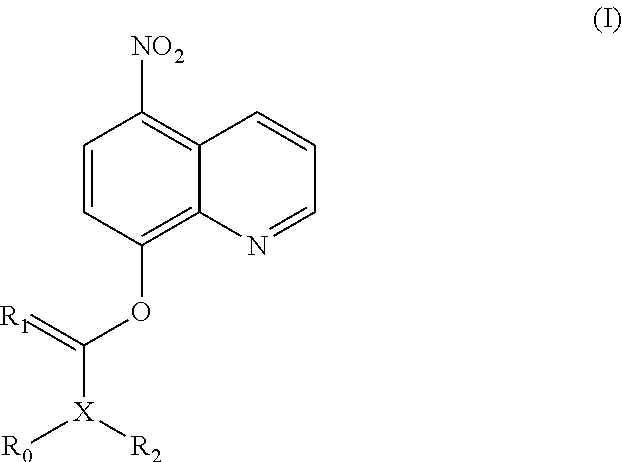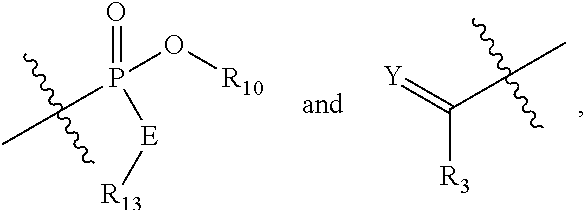Nitroxoline prodrug and use thereof
a technology of nitroxoline and prodrug, applied in the field of drugs, can solve the problems of limiting the application of nitroxoline in areas by the metabolic pathway, and achieve the effect of constant circulating concentration
- Summary
- Abstract
- Description
- Claims
- Application Information
AI Technical Summary
Benefits of technology
Problems solved by technology
Method used
Image
Examples
example 1
of (5-nitroquinolin-8-yloxy)methyl acetate (1)
[0217]
Step 1: Preparation of 5-nitro-8-chloromethoxyquinoline (1a)
[0218]Sodium bicarbonate aqueous solution (60 mL, 3.5 mol / L) and tetrabutyl ammonium hydrogen sulfate (TBAHS) (1.78 g, 5.24 mmol) were added to a solution of nitroxoline (10.00 g, 52.59 mmol) in dichloromethane (DCM) (100 mL) at room temperature, and the reaction solution was stirred for 20 minutes. Chloromethyl sulfurochloridate (10.42 g, 63.15 mmol) was added dropwise to the reaction system, followed by stirring at room temperature for 16 hours. The reaction solution was filtered. The organic phase was washed with potassium carbonate solution and saturated brine respectively, dried over anhydrous sodium sulfate, filtered and concentrated under reduced pressure. The residues were purified by silica gel column chromatography (eluent: dichloromethane) to obtain 5-nitro-8-chloromethoxyquinoline (2.5 g, yield: 20%).
Step 2: Preparation of (5-nitroquinolin-8-yloxy)methyl acetat...
example 2
of (5-nitroquinolin-8-yloxy)methyl propionate (2)
[0222]
[0223](5-Nitroquinolin-8-yloxy)methyl propionate (2) was obtained in accordance with the same preparation method of Example 1 except for replacing the acetic acid in Step 2 with propionic acid.
[0224]1H NMR (400 MHz, CDCl3) δ 9.19 (dd, J=8.9, 1.6 Hz, 1H), 9.07 (dd, J=4.1, 1.6 Hz, 1H), 8.50 (d, J=8.8 Hz, 1H), 7.72 (dd, J=8.9, 4.1 Hz, 1H), 7.37 (d, J=8.8 Hz, 1H), 6.19 (s, 2H), 2.44 (q, J=7.5 Hz, 2H), 1.17 (t, J=7.5 Hz, 3H).
[0225]MS calculated: 276.2; MS observed: 277.1 [M+H]+.
example 3
of (5-nitroquinolin-8-yloxy)methyl isobutyrate (3)
[0226]
[0227](5-Nitroquinolin-8-yloxy)methyl isobutyrate (3) was obtained in accordance with the same preparation method of Example 1 except for replacing the acetic acid in Step 2 with isobutyric acid.
[0228]1H NMR (400 MHz, CDCl3) δ 9.20 (dd, J=8.9, 1.6 Hz, 1H), 9.07 (dd, J=4.1, 1.6 Hz, 1H), 8.51 (d, J=8.8 Hz, 1H), 7.72 (dd, J=8.9, 4.1 Hz, 1H), 7.37 (d, J=8.8 Hz, 1H), 6.19 (s, 2H), 2.64 (hept, J=7.0 Hz, 1H), 1.19 (d, J=7.0 Hz, 6H).
[0229]MS calculated: 290.3; MS observed: 291.1 [M+H]+.
PUM
| Property | Measurement | Unit |
|---|---|---|
| temperature | aaaaa | aaaaa |
| temperature | aaaaa | aaaaa |
| temperature | aaaaa | aaaaa |
Abstract
Description
Claims
Application Information
 Login to View More
Login to View More - R&D
- Intellectual Property
- Life Sciences
- Materials
- Tech Scout
- Unparalleled Data Quality
- Higher Quality Content
- 60% Fewer Hallucinations
Browse by: Latest US Patents, China's latest patents, Technical Efficacy Thesaurus, Application Domain, Technology Topic, Popular Technical Reports.
© 2025 PatSnap. All rights reserved.Legal|Privacy policy|Modern Slavery Act Transparency Statement|Sitemap|About US| Contact US: help@patsnap.com



